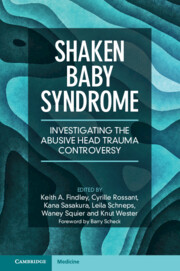Book contents
- Shaken Baby Syndrome
- Shaken Baby Syndrome
- Copyright page
- Dedication
- Contents
- Foreword
- About This Book
- Abbreviations
- Section 1 Prologue
- Section 2 Medicine
- Section 3 Science
- Chapter 10 The Swedish Systematic Literature Review on Suspected Traumatic Shaking (Shaken Baby Syndrome) and Its Aftermath
- Chapter 11 Interrogation and the Infanticide Suspect
- Chapter 12 Can Confession Substitute for Science in Shaken Baby Syndrome/Abusive Head Trauma?
- Chapter 13 Cognitive Bias in Medico-legal Judgments
- Chapter 14 Biomechanical Forensic Analysis of Shaking and Short-Fall Head Injury Mechanisms in Infants and Young Children
- Chapter 15 When Lack of Information Leads to Apparent Paradoxes and Wrong Conclusions
- Chapter 16 Epidemiology of Findings Claimed to Be Highly Specific for Shaken Baby Syndrome/Abusive Head Trauma, a Prerequisite to Improve Diagnosis of Child Abuse
- Chapter 17 Shaken Baby Syndrome
- Section 4 Law
- Section 5 International
- Section 6 Postface
- Appendix: Frequently Repeated Claims concerning Shaken Baby Syndrome
- Index
- Plate Section (PDF Only)
- References
Chapter 12 - Can Confession Substitute for Science in Shaken Baby Syndrome/Abusive Head Trauma?
from Section 3 - Science
Published online by Cambridge University Press: 07 June 2023
- Shaken Baby Syndrome
- Shaken Baby Syndrome
- Copyright page
- Dedication
- Contents
- Foreword
- About This Book
- Abbreviations
- Section 1 Prologue
- Section 2 Medicine
- Section 3 Science
- Chapter 10 The Swedish Systematic Literature Review on Suspected Traumatic Shaking (Shaken Baby Syndrome) and Its Aftermath
- Chapter 11 Interrogation and the Infanticide Suspect
- Chapter 12 Can Confession Substitute for Science in Shaken Baby Syndrome/Abusive Head Trauma?
- Chapter 13 Cognitive Bias in Medico-legal Judgments
- Chapter 14 Biomechanical Forensic Analysis of Shaking and Short-Fall Head Injury Mechanisms in Infants and Young Children
- Chapter 15 When Lack of Information Leads to Apparent Paradoxes and Wrong Conclusions
- Chapter 16 Epidemiology of Findings Claimed to Be Highly Specific for Shaken Baby Syndrome/Abusive Head Trauma, a Prerequisite to Improve Diagnosis of Child Abuse
- Chapter 17 Shaken Baby Syndrome
- Section 4 Law
- Section 5 International
- Section 6 Postface
- Appendix: Frequently Repeated Claims concerning Shaken Baby Syndrome
- Index
- Plate Section (PDF Only)
- References
Summary
Shaken baby syndrome/abusive head trauma struggles to find a solid scientific foundation, largely because of a circularity confound, the same diagnostic features under study serve as the basis for categorising cases for research purposes. In an attempt to overcome this circularity, researchers have turned to confessions as a sorting criterion in the research, under the belief that confessions are independent of the diagnostic features and hence not subject to circularity. However, none of the research examines the nature and reliability of the confessions, or the interrogations that produce them; they simply accept the confessions as true, reliable, and independent. Research on interrogations and false confessions, however, along with extensive and wholly consistent anecdotal evidence, strongly suggest that SBS/AHT confessions are largely if not entirely produced by interrogator reliance on the diagnostic findings. That reliance undermines both the independence of the confessions, and hence their ability to break free from circularity, and the reliability of these confessions as a group. On the current state of knowledge, confessions cannot be relied upon to substitute for science to support the SBS/AHT hypothesis.
Keywords
- Type
- Chapter
- Information
- Shaken Baby SyndromeInvestigating the Abusive Head Trauma Controversy, pp. 189 - 204Publisher: Cambridge University PressPrint publication year: 2023

